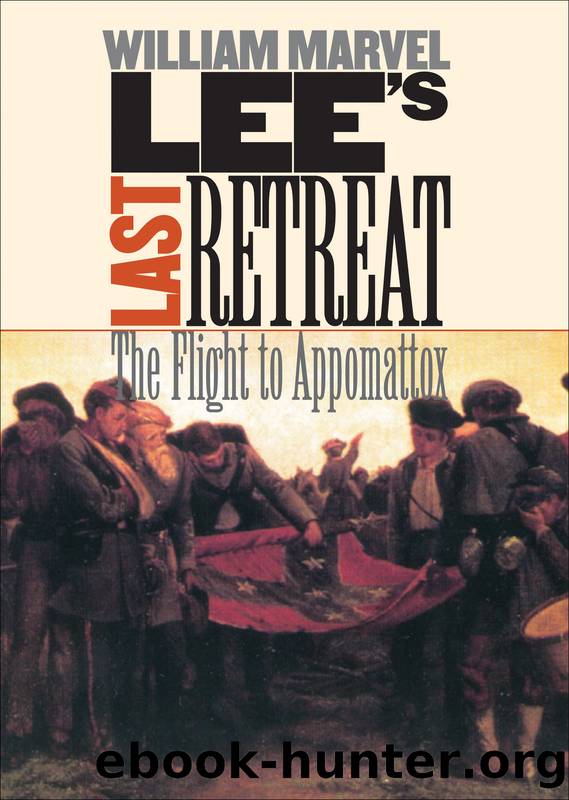Lee's Last Retreat by William Marvel

Author:William Marvel
Language: eng
Format: epub
Publisher: The University of North Carolina Press
Published: 2002-12-15T00:00:00+00:00
CHAPTER 9
[ Peace ]
When word of Leeâs surrender reached the Second Corps lines at New Hope Church, George Meadeâs chief of staff prevailed on him to emerge from his ambulance and announce the news to his troops. The general did more than that: he shook off his fever, climbed on a horse, and went barreling back up the stage road, waving his hat and shouting to everyone he saw that the war was over and now they could all go home. His announcement brought pandemonium among his troops, most of whom began their celebration by throwing their hats into the air and stamping on them; the military successes of the past week had worn heavily on this armyâs headgear.1
âOf course this ends the war,â thought one of Sheridanâs officers. âI am in hopes that twenty days will see the end of the war,â wrote another. âI think the other rebel armies will capitulate as soon as they get word of Leeâs surrender,â a Massachusetts soldier told his sister; âpeace must speedily follow.â âFrom this epoch dates the downfall of the rebellion,â a cavalryman informed his mother.2
These sentiments flourished in Grantâs army, across the North, and probably throughout most of the South, where much of the populace had come to view General Lee himself as the embodiment of Confederate hopes. To many whose opinion mattered, though, the finality of Leeâs surrender did not seem so obvious. A significant number of Confederates, official and civilian, had remained confident of ultimate victory through the terrible winter of 1865; for them it was merely the Valley Forge of their own war of independence. Even the elimination of their most celebrated army failed to quell that confidence entirely, but the most enthusiastic devotion could not sustain a cause that the majority thought was lost. At the very moment the defeated Robert E. Lee rode toward his last headquarters encampment, a Union army outside Mobile, Alabama, was deploying for an assault that would see 600 more Union soldiers fall; the assault nonetheless succeeded because, apparently, the Confederates in Fort Blakely defended their imposing works with insufficient spirit. On that same day, near Smithfield, North Carolina, General Joseph E. Johnston reorganized the Army of Tennessee into three corps to continue the fight against William T. Sherman, although as soon as official word of Leeâs surrender reached his army his men began drifting away; the moment he agreed to his own truce with Sherman, his little army began to dissolve altogether.3 Eleven days after the meeting at the McLean house, a cavalry officer from South Carolinaâwhere secession was conceived, born, and nurturedâsent his district commander a copy of the Charleston Courier that carried the details of the surrender, commenting upon âthis stupendous forgery.â Yet a Charleston woman not only believed the report; she also read into it the doom of the Confederacy, remarking to her aunt âI do not see how Johnstonâs army can escape, surrender must be made.â4
Confederate troops roamed freely in Texas, Louisiana, and what would come to be called Oklahoma.
Download
This site does not store any files on its server. We only index and link to content provided by other sites. Please contact the content providers to delete copyright contents if any and email us, we'll remove relevant links or contents immediately.
In Cold Blood by Truman Capote(3136)
Steve Jobs by Walter Isaacson(2763)
The Innovators: How a Group of Hackers, Geniuses, and Geeks Created the Digital Revolution by Walter Isaacson(2487)
All the President's Men by Carl Bernstein & Bob Woodward(2261)
Lonely Planet New York City by Lonely Planet(2101)
The Room Where It Happened by John Bolton;(2032)
And the Band Played On by Randy Shilts(2014)
The Murder of Marilyn Monroe by Jay Margolis(1977)
The Poisoner's Handbook by Deborah Blum(1977)
The Innovators by Walter Isaacson(1970)
Lincoln by David Herbert Donald(1866)
A Colony in a Nation by Chris Hayes(1796)
Under the Banner of Heaven: A Story of Violent Faith by Jon Krakauer(1682)
Amelia Earhart by Doris L. Rich(1585)
The Unsettlers by Mark Sundeen(1583)
Birdmen by Lawrence Goldstone(1532)
Zeitoun by Dave Eggers(1516)
Dirt by Bill Buford(1516)
Decision Points by George W. Bush(1462)
